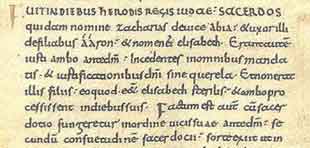
Back Каралінгскі мінускул Byelorussian Каролингски минускул Bulgarian Escriptura carolíngia Catalan Karolina (písmo) Czech Karolingische Minuskel German Karolida minuskla skribo Esperanto Minúscula carolingia Spanish Karolingide minuskel Estonian Karolinginen minuskeli Finnish Minuscule caroline French


Carolingian minuscule or Caroline minuscule is a script which developed as a calligraphic standard in the medieval European period so that the Latin alphabet of Jerome's Vulgate Bible could be easily recognized by the literate class from one region to another. It is thought to have originated before 778 CE at the scriptorium of the Benedictine monks of Corbie Abbey, about 150 kilometres (95 miles) north of Paris, and then developed by Alcuin of York for wide use in the Carolingian Renaissance.[1][2][3] Alcuin himself still wrote in a script which was a precursor to the Carolingian minuscule, which slowly developed over three centuries.[4][5] He was most likely responsible for copying and preserving the manuscripts[6] and upkeep of the script.[7] It was used in the Holy Roman Empire between approximately 800 and 1200. Codices, pagan[citation needed] and Christian texts, and educational material were written in Carolingian minuscule.
After blackletter developed out of it, the Carolingian minuscule became obsolete, until the 14th century Italian Renaissance, when the humanist minuscule script was also developed from it. By this latter line the Carolingian minuscule is a direct ancestor of most modern-day Latin letter scripts and typefaces.
- ^ Knox, E.L. Skip. "Carolingian Handwriting", Boise State University
- ^ "Caroline Minuscule Predates Charlemagne", Heidelberg University, 9 January 2013
- ^ Colish, Marcia L. (1999). Medieval Foundations of the Western Intellectual Tradition, 400–1400. The Yale Intellectual History of the West. Yale University Press. p. 67. ISBN 9780300078527.
- ^ Rosamond, McKitterick. The Frankish Kingdoms Under the Carolingians, 751-987. Routledge, 2018, 150-157.
- ^ Dales, Douglas (2013). Alcuin II: Theology and Thought. ISD LLC. ISBN 978-0-227-90087-1.
- ^ Bowen, James (2018). Hist West Educ:Civil Europe V2. Routledge. ISBN 978-1-136-50096-1.
- ^ Morison, Stanley (2009). Selected Essays On the History of Letter-forms in Manuscript and Print. Cambridge University Press. ISBN 978-0-521-18316-1.
© MMXXIII Rich X Search. We shall prevail. All rights reserved. Rich X Search